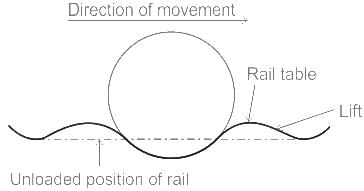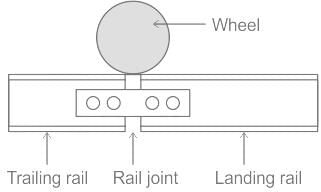Civil Engineering (CE) Exam > Civil Engineering (CE) Questions > The longitudinal movement of the rails in a t...
Start Learning for Free
The longitudinal movement of the rails in a track is technically known as
- a)Buckling
- b)Hogging
- c)Creeping
- d)Cracking
Correct answer is option 'C'. Can you explain this answer?
Verified Answer
The longitudinal movement of the rails in a track is technically known...
Creep of rail:
- Creep is defined as the longitudinal movement of the rail with respect to the sleepers. Rails tend to gradually move in the direction of dominant traffic.
Theories for the development of creep
1) Wave motion theory:
1) Wave motion theory:
- According to this theory the rails have a wavy formation, as the wheels move forward, the depression also moves with them and the previously depressed portion springs back to the original one.

2) Percussion theory:
- According to this theory, creep is developed due to the impact of wheels at the rail end ahead of the joint. The continuous movement of several wheels passing over the joint pushes the facing or landing rail forward, thereby causing creep

Major causes for creep in rail are as follows:
- Forces developed when the train is starting or stopping by application of brakes.
- While starting, the wheels push the rail backwards and hence the direction of creep is in the backward direction.
- When brakes are applied then the wheels of the vehicles push the rails in the forward direction and hence the creep is in the forward direction.
- Due to wave motions developed when the wheels of the vehicle hit the crest.
- Unequal expansion/contraction due to the different temperature gradient along the track.
Most Upvoted Answer
The longitudinal movement of the rails in a track is technically known...
Understanding Rail Movement in Tracks
The longitudinal movement of rails in a track is referred to as "creeping." This phenomenon is essential to understand for maintaining the integrity and safety of railway systems.
What is Creeping?
- Creeping occurs when the rails move longitudinally along the track due to thermal expansion and contraction, as well as the dynamic forces exerted by trains.
- This movement can lead to misalignment and deformation of the track, impacting train safety and operational efficiency.
Causes of Creeping
- **Thermal Expansion:** Rails expand in high temperatures and contract in cooler conditions, causing them to shift.
- **Dynamic Loads:** The weight and momentum of trains can exert forces that push the rails, leading to gradual displacement.
- **Track Design and Maintenance:** Poorly maintained tracks or improper installation can exacerbate creeping.
Consequences of Creeping
- **Safety Risks:** Misaligned tracks can lead to derailments, posing significant safety hazards.
- **Increased Maintenance Costs:** Frequent adjustments and repairs are required to counteract the effects of creeping, leading to higher operational costs.
- **Operational Delays:** Track misalignment can slow down train movements, leading to delays in the transportation schedule.
Preventive Measures
- **Regular Inspections:** Frequent monitoring of track alignment can help detect creeping early.
- **Thermal Stresses Management:** Use of expansion joints and proper rail fastening systems can mitigate thermal effects.
- **Proper Track Installation:** Ensuring correct installation practices can reduce the likelihood of creeping.
In summary, understanding and managing rail creeping is crucial for the safety and efficiency of railway operations.
The longitudinal movement of rails in a track is referred to as "creeping." This phenomenon is essential to understand for maintaining the integrity and safety of railway systems.
What is Creeping?
- Creeping occurs when the rails move longitudinally along the track due to thermal expansion and contraction, as well as the dynamic forces exerted by trains.
- This movement can lead to misalignment and deformation of the track, impacting train safety and operational efficiency.
Causes of Creeping
- **Thermal Expansion:** Rails expand in high temperatures and contract in cooler conditions, causing them to shift.
- **Dynamic Loads:** The weight and momentum of trains can exert forces that push the rails, leading to gradual displacement.
- **Track Design and Maintenance:** Poorly maintained tracks or improper installation can exacerbate creeping.
Consequences of Creeping
- **Safety Risks:** Misaligned tracks can lead to derailments, posing significant safety hazards.
- **Increased Maintenance Costs:** Frequent adjustments and repairs are required to counteract the effects of creeping, leading to higher operational costs.
- **Operational Delays:** Track misalignment can slow down train movements, leading to delays in the transportation schedule.
Preventive Measures
- **Regular Inspections:** Frequent monitoring of track alignment can help detect creeping early.
- **Thermal Stresses Management:** Use of expansion joints and proper rail fastening systems can mitigate thermal effects.
- **Proper Track Installation:** Ensuring correct installation practices can reduce the likelihood of creeping.
In summary, understanding and managing rail creeping is crucial for the safety and efficiency of railway operations.

|
Explore Courses for Civil Engineering (CE) exam
|

|
Similar Civil Engineering (CE) Doubts
The longitudinal movement of the rails in a track is technically known asa)Bucklingb)Hoggingc)Creepingd)CrackingCorrect answer is option 'C'. Can you explain this answer?
Question Description
The longitudinal movement of the rails in a track is technically known asa)Bucklingb)Hoggingc)Creepingd)CrackingCorrect answer is option 'C'. Can you explain this answer? for Civil Engineering (CE) 2025 is part of Civil Engineering (CE) preparation. The Question and answers have been prepared according to the Civil Engineering (CE) exam syllabus. Information about The longitudinal movement of the rails in a track is technically known asa)Bucklingb)Hoggingc)Creepingd)CrackingCorrect answer is option 'C'. Can you explain this answer? covers all topics & solutions for Civil Engineering (CE) 2025 Exam. Find important definitions, questions, meanings, examples, exercises and tests below for The longitudinal movement of the rails in a track is technically known asa)Bucklingb)Hoggingc)Creepingd)CrackingCorrect answer is option 'C'. Can you explain this answer?.
The longitudinal movement of the rails in a track is technically known asa)Bucklingb)Hoggingc)Creepingd)CrackingCorrect answer is option 'C'. Can you explain this answer? for Civil Engineering (CE) 2025 is part of Civil Engineering (CE) preparation. The Question and answers have been prepared according to the Civil Engineering (CE) exam syllabus. Information about The longitudinal movement of the rails in a track is technically known asa)Bucklingb)Hoggingc)Creepingd)CrackingCorrect answer is option 'C'. Can you explain this answer? covers all topics & solutions for Civil Engineering (CE) 2025 Exam. Find important definitions, questions, meanings, examples, exercises and tests below for The longitudinal movement of the rails in a track is technically known asa)Bucklingb)Hoggingc)Creepingd)CrackingCorrect answer is option 'C'. Can you explain this answer?.
Solutions for The longitudinal movement of the rails in a track is technically known asa)Bucklingb)Hoggingc)Creepingd)CrackingCorrect answer is option 'C'. Can you explain this answer? in English & in Hindi are available as part of our courses for Civil Engineering (CE).
Download more important topics, notes, lectures and mock test series for Civil Engineering (CE) Exam by signing up for free.
Here you can find the meaning of The longitudinal movement of the rails in a track is technically known asa)Bucklingb)Hoggingc)Creepingd)CrackingCorrect answer is option 'C'. Can you explain this answer? defined & explained in the simplest way possible. Besides giving the explanation of
The longitudinal movement of the rails in a track is technically known asa)Bucklingb)Hoggingc)Creepingd)CrackingCorrect answer is option 'C'. Can you explain this answer?, a detailed solution for The longitudinal movement of the rails in a track is technically known asa)Bucklingb)Hoggingc)Creepingd)CrackingCorrect answer is option 'C'. Can you explain this answer? has been provided alongside types of The longitudinal movement of the rails in a track is technically known asa)Bucklingb)Hoggingc)Creepingd)CrackingCorrect answer is option 'C'. Can you explain this answer? theory, EduRev gives you an
ample number of questions to practice The longitudinal movement of the rails in a track is technically known asa)Bucklingb)Hoggingc)Creepingd)CrackingCorrect answer is option 'C'. Can you explain this answer? tests, examples and also practice Civil Engineering (CE) tests.

|
Explore Courses for Civil Engineering (CE) exam
|

|
Signup for Free!
Signup to see your scores go up within 7 days! Learn & Practice with 1000+ FREE Notes, Videos & Tests.
























